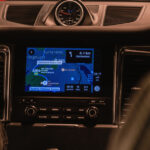Got a Fetish for Upskirt Photos? Work for Service NSW

A female driver made a formal complaint to Service NSW after the government agency sent a compromising photo taken by a mobile phone detection to her home address.
The woman received a fine for using a mobile phone while driving accompanied by a photo to prove the commission of the offence – one which captured not just the phone use, but her underwear between her skirt.
‘Upskirt photo’
According to Cinzia Lee, her complaint was met with confirmation that “someone in the office does look at the photos,” but the organisation ignored her concerns about the inappropriateness of cameras angled in such a way as to breach a person’s physical privacy, only to later be viewed by public service staff and sent in a manner whereby it could potentially be viewed by others at the premises in which she resides.
In protest, Ms Lee elected to take the matter to court where she pleaded guilty to the offence but, in doing so, was able to bring attention to the situation.
The Presiding Magistrate heard submissions before dismissing the case under section 10(1)(a) of the Crimes (Sentencing Procedure) Act 1999, enabling Ms Lee to avoid both a court-imposed fine of up to $2,200 and five demerit points.
Government review
Ms Lee’s experience has prompted a Government review into the way sensitive images are handled by Services NSW.
The incident follows a similar one in Queensland earlier this year, when a woman’s underwear was snapped by a roadside camera.
The penalty for handling a mobile phone while driving
When not taken to court, the penalty notice for handling a mobile phone while driving is $362 and five demerit points.
The penalty increases to 10 demerit points during double-demerit periods.
It is one of the most costly traffic fines a person can receive in New South Wales, and with good reason.
Mobile driving offences in NSW
Using mobile phones while driving causes drivers to take their eyes off the road, and hands off the wheel, and it can also create ‘distraction’ which takes their mind off driving. Studies show that this results in longer reaction times, impaired ability to keep within the lane of the road,
Some studies suggest that drivers using a mobile phone are four times more likely to be involved in a crash than when a driver does not use a phone.
Controversial cameras
New South Wales Police continue to enforce illegal mobile phone use and issue infringements as part of regular operations.
In 2019, the New South Wales Government invested heavily in a network of controversial high definition cameras capable of capturing images at long distances, often perched high above roads across the state.
The cameras were subject to a trial period until March 2020, and when they finally became officially operational, almost 13,000 fines were issued in one month, earning the NSW Government more than $7 million.
The cameras have long been criticised as an ‘easy revenue-raiser’ for the Government.
They’ve also long been a significant concern for privacy advocates.
New South Wales is highly monitored by CCTV cameras, continually justified as necessary for fighting crime, and as a tool for law enforcement. The success or otherwise of camera technology is not in dispute in relation to these activities, but they are, without a doubt, a massive infringement on our personal privacy.
The criminal offence of filming a person’s private parts without consent
It’s interesting to note that if an actual person took the same photograph as the one taken of Ms Lee, they could potentially be charged with filming a person’s private parts without consent, which is a criminal offence under section 91L(1) of the Crimes Act 1900 that carries a maximum penalty of two years in prison.
To establish the offence, the prosecution must prove beyond reasonable doubt that:
The accused person filmed another person’s private parts, and did so without the other person’s consent, knowing that the other person did not consent.
The prosecution must also prove that the accused person did so to obtain, or enable another person to obtain, sexual arousal or sexual gratification, and the circumstances were such that a reasonable person would not expect their private parts to be filmed.
‘Private parts’ is defined as:
The genital or anal area, whether bare or covered by underwear, or the breasts of a female, or transgender or intersex person identifying as female whether or not the breasts are developed.
A person can also be found guilty if they attempted to commit the offence but failed to do so.







